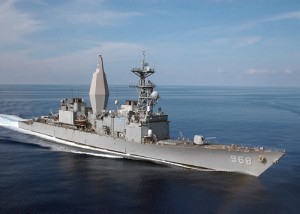
OCEAN CITY — One year after being ceremoniously sunk about 30 miles off the coast of Ocean City, the retired Navy destroyer U.S.S. Arthur W. Radford is already teeming with sea life and is serving its intended purpose as a vast artificial reef system.
Last August, the 536-foot Spruance class Radford, decommissioned by the Navy and retired to dry dock for several years, was sunk to the bottom of the ocean about 30 miles off the coast of the resort, becoming the centerpiece of a vast three-state artificial reef system in a partnership that included Maryland, Delaware, New Jersey and the U.S. Navy. After months of mitigation, litigation and red tape, the massive Radford was sunk in an area equidistant from the coasts of the three participating states on a permitted artificial reef site named “Del-Jersey-Land.”
The Radford was sunk in an area about 32 miles east-northeast from the Ocean City Inlet, 28 miles due east of the Indian River Inlet and 30 miles southeast of Cape May, N.J. It was sunk in about 130 feet of water and created a vertical profile from the sea floor of about 70 feet, along with its 560-foot-plus length.
The Radford became the largest warship ever sunk as part of an artificial reef system off the East Coast. The 910-foot former aircraft carrier Oriskany was sunk in the Gulf of Mexico off the coast of Pensicola, Fla. in 2006, becoming the largest warship ever sunk for the purpose of creating an artificial reef.
The intent was to utilize the decommissioned destroyer to create an artificial reef system, enhancing habitat for a variety of species while creating recreational fishing and diving opportunities, and an economic boon, for the three states that helped finance the project.
Just weeks after it was sent to the bottom, the Radford was broken up into three large pieces by the effects of Hurricane Irene, which bumped the mid-Atlantic coast late last August. However, the breaking up of the vessel did not curtail its development as an artificial reef and may have expedited the process, according to Tim Mullane, managing director of the American Marine Group, the private company that coordinated the sinking last August.
“The Radford, of course, broke into three pieces during Irene and the reports I have received and some footage show that not only has the main section of the hull stayed perfectly upright, but the ship has significant growth on it and is alive with sea life,” said Mullane this week. “The footage I have seen shows billions, yes billions, of mussels, starfish and other diverse sea life.”
O.C. Diver owner and operator Ted Green, who has taken dozens of charters to the Radford site over the last year including one last week, agreed the destroyer turned artificial reef is exceeding expectations.
“It’s way ahead of where we thought it would be,” he said. “We expected it to start crusting up this year, but we really thought it would take four to five years to really blossom. It’s ahead of schedule.”
Green explained the Radford is no longer intact after Irene, but the main center section is exactly where it was sunk and has scoured nicely into the bottom.
“It’s broken into three pieces,” he said. “The center section, or vertical bulkhead, has settled into the bottom just as it was sunk and remains upright. That’s the main attraction. The hurricane moved the pieces around and the bow is about 100 feet from the main wreck.”
Green said the main section is upright and intact and is about 100 yards long and about 50 feet wide. The tallest structures at the center of the vessel stand about 65 feet high or over six stories tall. With the shell of the former Navy vessel crusting over with mussels and other sea life, it has already become a diver’s paradise.
“The entire thing is crusted over with mussel spat,” he said. “It’s up-current from another wreck covered with mature mussels and the mussel spat from that wreck has drifted down and completely covered the Radford. The mussel spat is providing a huge food source for other fish, but they’re also filter feeders, so the billions of mussels on the vessel are actually helping to keep the water clear.”
Green said the crusted over Radford also creates some challenges for divers because the empty spaces in the vessel are not always clearly identified.
“For divers, it’s really a double-edged sword,” he said. “The vessel is teeming with sea life and lobsters, which is an added bonus, but the crusting creates some challenges because the points of interest in the ship are less clearly identifiable. It’s looking less and less like a wreck, and the divers get preoccupied with the sea life and forget how they got into certain areas. They really have to stay focused to remember how to get out.”
